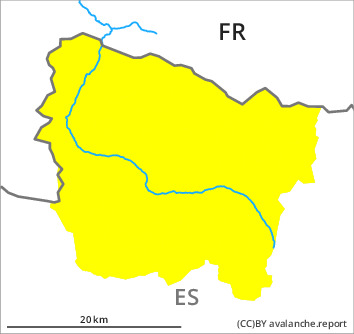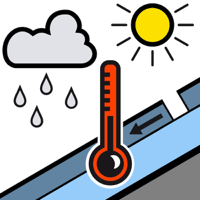
Danger level

2500m
Avalanche Problem

Wet snow

2500m


Persistent weak layer

2000m


Moist snow slides and avalanches require caution. Dry slab avalanches are possible in isolated cases as before.
As the moisture increases more moist snow slides and avalanches are possible at any time, but they will be mostly small. These can be released by people or triggered naturally. On very steep shady slopes the likelihood of avalanches being released is greater.
The hard wind slabs can still be released in some cases on very steep, little used north facing slopes above approximately 2000 m, especially at their margins. They are lying on top of a weakly bonded old snowpack especially on wind-protected shady slopes. In very isolated cases the avalanches are medium-sized. In particular at the southern border of Aran the avalanche prone locations are more prevalent and the danger is slightly greater.
The hard wind slabs can still be released in some cases on very steep, little used north facing slopes above approximately 2000 m, especially at their margins. They are lying on top of a weakly bonded old snowpack especially on wind-protected shady slopes. In very isolated cases the avalanches are medium-sized. In particular at the southern border of Aran the avalanche prone locations are more prevalent and the danger is slightly greater.
Snowpack
>
The hard wind slabs are lying on top of a weakly bonded old snowpack on shady slopes. Snow profiles and stability tests indicate poor snowpack stability in particular in shady places that are protected from the wind.
Several small moist snow slides and avalanches have been released as the moisture increases. The sleet will give rise by late in the night to increasing moistening of the snowpack on shady slopes at low and intermediate altitudes.
At intermediate and high altitudes there are 40 to 100 cm of snow, and even more in some localities. In high Alpine regions snow depths vary greatly, depending on the infuence of the wind.
Several small moist snow slides and avalanches have been released as the moisture increases. The sleet will give rise by late in the night to increasing moistening of the snowpack on shady slopes at low and intermediate altitudes.
At intermediate and high altitudes there are 40 to 100 cm of snow, and even more in some localities. In high Alpine regions snow depths vary greatly, depending on the infuence of the wind.
Tendency
Thursday: Gradual increase in danger of dry avalanches as a consequence of the snowfall. Gradual decrease in danger of moist avalanches as the temperature drops.